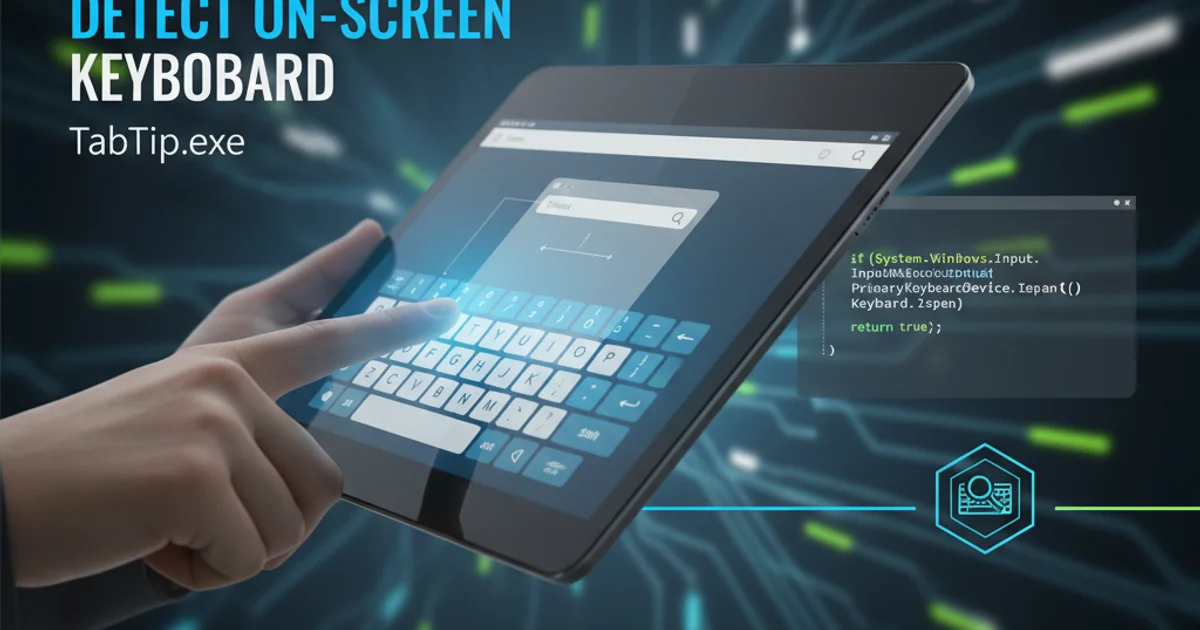Detect if on-screen keyboard is open (TabTip.exe)
Categories:
Detecting the On-Screen Keyboard (TabTip.exe) in C#

Learn how to programmatically detect if the Windows on-screen keyboard (TabTip.exe) is currently active or running in your C# applications, crucial for touch-enabled interfaces.
Developing applications for touch-enabled Windows devices often requires awareness of the on-screen keyboard's state. The Windows on-screen keyboard, typically managed by TabTip.exe, can obscure parts of your application's UI or affect user input flow. Accurately detecting its presence allows your application to adapt its layout, scroll content, or adjust input fields to provide a seamless user experience. This article will guide you through various C# methods to reliably determine if TabTip.exe is running.
Understanding TabTip.exe and Its Behavior
The TabTip.exe process is the executable responsible for the touch keyboard (also known as the on-screen keyboard) in Windows. It's automatically launched by the operating system when a touch input field gains focus on a touch-enabled device, or when manually invoked by the user. Unlike traditional applications, TabTip.exe doesn't always have a visible window that can be easily queried. Its behavior can also vary slightly between Windows versions (e.g., Windows 8/8.1 vs. Windows 10/11).
flowchart TD
A[Application Starts] --> B{Touch Input Field Focused?}
B -->|Yes| C[Windows Launches TabTip.exe]
C --> D{Is TabTip.exe Running?}
D -->|Yes| E[Application Adapts UI]
D -->|No| F[Application Continues Normally]
B -->|No| FFlowchart illustrating the on-screen keyboard detection process.
Method 1: Checking for the TabTip.exe Process
The most straightforward way to detect if the on-screen keyboard is active is to check for the presence of the TabTip.exe process. This method is generally reliable across different Windows versions. You can use the System.Diagnostics.Process class in C# to enumerate running processes and look for TabTip.exe.
using System.Diagnostics;
using System.Linq;
public static class OnScreenKeyboardDetector
{
public static bool IsOnScreenKeyboardOpen()
{
Process[] processes = Process.GetProcessesByName("TabTip");
return processes.Any();
}
// Example usage:
// bool isOpen = IsOnScreenKeyboardOpen();
// if (isOpen)
// {
// Console.WriteLine("On-screen keyboard is open.");
// }
// else
// {
// Console.WriteLine("On-screen keyboard is closed.");
// }
}
C# code to detect TabTip.exe process.
TabTip.exe is effective, remember that the process might be running in the background even if the keyboard UI is not currently visible. For more precise UI adaptation, consider combining this with methods that check window visibility or input focus.Method 2: Monitoring Process Lifetime for Dynamic Detection
For applications that need to react dynamically to the on-screen keyboard opening or closing, continuously polling for the process might be inefficient. A better approach is to monitor process creation and termination events. This can be achieved using ManagementEventWatcher from the System.Management namespace, which allows you to subscribe to WMI (Windows Management Instrumentation) events.
using System;
using System.Management;
public class OnScreenKeyboardMonitor
{
private ManagementEventWatcher _startWatcher;
private ManagementEventWatcher _stopWatcher;
public event EventHandler OnScreenKeyboardOpened;
public event EventHandler OnScreenKeyboardClosed;
public OnScreenKeyboardMonitor()
{
// Watch for process start events
_startWatcher = new ManagementEventWatcher(
new WqlEventQuery("SELECT * FROM __InstanceCreationEvent WITHIN 1 WHERE TargetInstance ISA 'Win32_Process' AND TargetInstance.Name = 'TabTip.exe'"));
_startWatcher.EventArrived += (sender, e) => OnScreenKeyboardOpened?.Invoke(this, EventArgs.Empty);
// Watch for process stop events
_stopWatcher = new ManagementEventWatcher(
new WqlEventQuery("SELECT * FROM __InstanceDeletionEvent WITHIN 1 WHERE TargetInstance ISA 'Win32_Process' AND TargetInstance.Name = 'TabTip.exe'"));
_stopWatcher.EventArrived += (sender, e) => OnScreenKeyboardClosed?.Invoke(this, EventArgs.Empty);
}
public void StartMonitoring()
{
_startWatcher.Start();
_stopWatcher.Start();
}
public void StopMonitoring()
{
_startWatcher.Stop();
_stopWatcher.Stop();
}
// Example usage in a WPF/WinForms app:
// OnScreenKeyboardMonitor monitor = new OnScreenKeyboardMonitor();
// monitor.OnScreenKeyboardOpened += (s, e) => Console.WriteLine("OSK Opened!");
// monitor.OnScreenKeyboardClosed += (s, e) => Console.WriteLine("OSK Closed!");
// monitor.StartMonitoring();
// ... when application exits: monitor.StopMonitoring();
}
C# code for monitoring TabTip.exe process creation and deletion events.
System.Management requires adding a reference to System.Management.dll in your project. Be aware that WMI events can sometimes have a slight delay, and this approach might not capture every single transient state change instantly.Considerations for Different Windows Versions and UI Adaptation
While TabTip.exe detection is a good starting point, the actual behavior and UI impact of the on-screen keyboard can vary:
- Windows 8/8.1: The on-screen keyboard often behaves more like a traditional application window.
- Windows 10/11: The touch keyboard is more integrated into the shell, sometimes appearing as an overlay that doesn't always register as a distinct top-level window in the same way.
For more robust UI adaptation, especially in WPF or UWP applications, you might also need to consider:
InputPane(UWP): UWP applications have direct access to theInputPaneclass, which provides events for when the input pane (including the touch keyboard) is showing or hiding, along with its occluded rectangle.- Window Resizing/Movement: Observe if your application's main window is being resized or moved by the OS when the keyboard appears. This can be an indirect indicator.
- Focus Changes: Monitor focus changes within your application. If a text input control gains focus and
TabTip.exeis running, it's highly probable the keyboard is visible and active.
1. Step 1: Add System.Management Reference
If using the ManagementEventWatcher method, right-click on your project in Solution Explorer, select 'Add' -> 'Reference...', then search for and add System.Management.
2. Step 2: Implement Process Detection
Integrate the IsOnScreenKeyboardOpen() method into your application logic where you need to check the keyboard's status. This could be in response to a UI event or a timer.
3. Step 3: Implement Event Monitoring (Optional)
For dynamic responses, instantiate OnScreenKeyboardMonitor, subscribe to its OnScreenKeyboardOpened and OnScreenKeyboardClosed events, and call StartMonitoring() when your application initializes. Remember to call StopMonitoring() on application shutdown.
4. Step 4: Adapt Your UI
Based on the detection, adjust your UI. This might involve scrolling a ScrollViewer to bring an input field into view, resizing a Grid row, or moving a custom control.